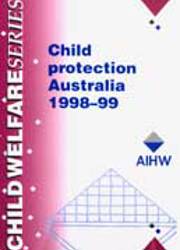Summary
This report is based on the following three national child protection data collections:
- child protection notifications, investigations and substantiations;
- children on care and protection orders; and
- children in supported out-of-home overnight care.
These data are collected each year by the Australian Institute of Health and Welfare from the community service departments in each State and Territory. The data in this report cover the 1998-99 financial year. Each State and Territory has its own legislation, policies and practices in relation to child protection, so there are differences between jurisdictions in the data provided. Australian totals have not been provided for those data that are not consistent across the States and Territories.
The main points of interest in the report are:
- The number of child protection notifications in 1998-99 was higher than in 1997-98 in New South Wales, Victoria, Queensland, Western Australia, South Australia and the Australian Capital Territory.
- The majority of notifications in 1998-99 were subject to an investigation. Although the outcomes of investigations varied across States and Territories, in all jurisdictions a large proportion of investigations were not substantiated: that is, there was no reasonable cause to believe that the child was being, or was likely to be, abused or neglected or otherwise harmed. For example, 54% of finalised investigations in New South Wales and 59% in South Australia were not substantiated.
- Between 1997-98 and 1998-99 the number of substantiations increased slightly in Queensland, Western Australia, South Australia and the Australian Capital Territory, but decreased in New South Wales, Victoria and Tasmania.
- Rates of children who were the subject of a child protection substantiation in 1998-99 ranged from 1.1 per 1,000 children aged 0-16 years in Tasmania to 6.3 per 1,000 in Victoria.
- While the quality of data on Indigenous status varies between States and Territories, Indigenous children were clearly over-represented in substantiations of child abuse and neglect. For example, the rate of Indigenous children who were the subject of a substantiation was over 5 times higher than the rate for other children in Western Australia and South Australia.
- There were 8,487 children admitted to care and protection orders and arrangements across Australia during 1998-99.
- Of those children admitted to orders in 1998-99, 42% were aged under 5 years with 13% aged less than 1 year.
- There were 3.8 children per 1,000 aged 0-17 years on care and protection orders in
- Australia at 30 June 1999.
- The rate of children on care and protection orders varied across States and Territories ranging from 2.1 per 1,000 in Western Australia to 4.4 per 1,000 in New South Wales. In all jurisdictions the rate of Indigenous children on care and protection orders was higher than the rate for other children.
- There were 15,674 children in out-of-home care at 30 June 1999. Most of these children (88%) were in home-based care arrangements, with a further 8% in facility-based care.
- The rate of children in out-of-home care at 30 June 1999 was 3.3 per 1,000 aged 0-17 years. This rate ranged from 2.2 per 1,000 in the Australian Capital Territory to 4.0 per 1,000 in New South Wales.
- Indigenous children were also over-represented among children in out-of-home care. For example, in New South Wales Indigenous children were 9 times more likely than other children to be in out-of-home care.



